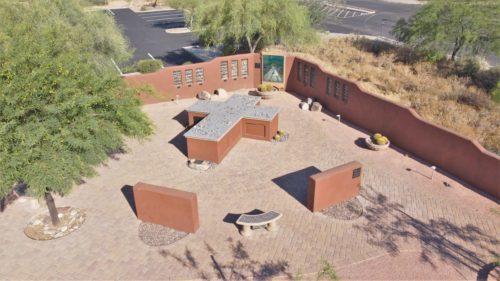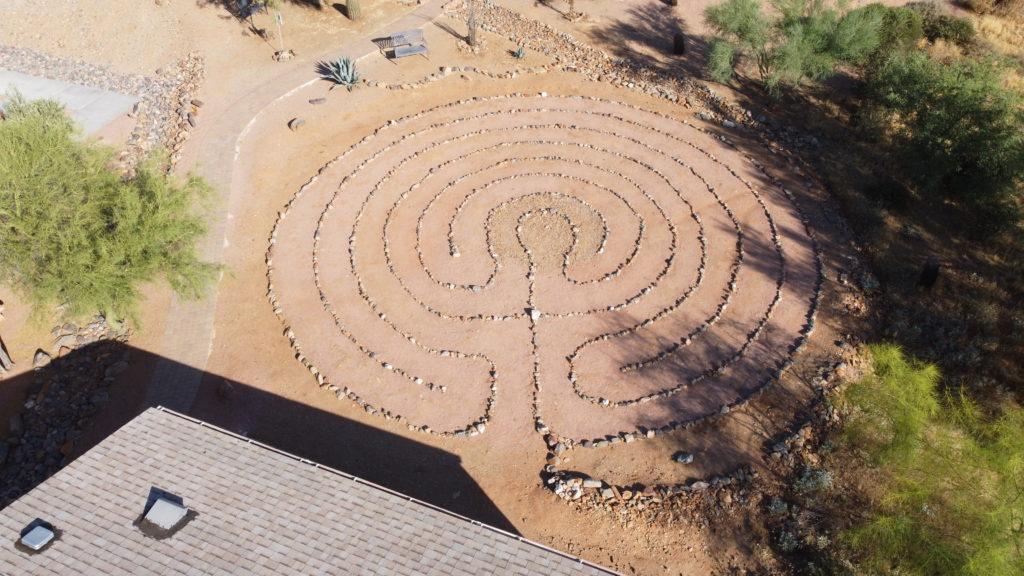What is a Columbarium?
col•um•bar•i•um
• a stone wall or walk within a garden for burial of funeral urns, esp. attached to a church.
A Columbarium consists of secure niches where urns containing the ashes of loved ones are placed

Why?
For centuries, it has been the obligation of the church to serve its congregation from birth to death. As churchyard burial is no longer feasible for most churches, a columbarium provides a natural alternative. Besides the practical advantages of being much more affordable for the average family and being an environmentally sensitive and efficient use of space, it also strengthens the ties between families and their faith community. In addition, columbaria are quickly becoming one of the most popular choices of a final resting place in the United States. Arizona’s cremation rate has gone up to 70% in recent years.
Where?
The Fountains’ Memorial Garden and Columbarium can be found bordering on the North end of the Church property. View the Campus Map.
Find out More: Click on the links below to view documents outlining the cost and other details. Brochures are available at the church office.
The Labyrinth
Labyrinths have frequently been used for spiritual purposes. They can create a heightened awareness of the human condition and aid psychological and spiritual growth. To build a labyrinth is to create a sacred space. To walk a labyrinth is to imbue it with power and meaning. The more a labyrinth is used the more powerful it becomes as a symbol of transformation. The vision of the Labyrinth Society and Veriditas is to establish labyrinths in cathedrals, retreat centers, hospitals, prisons, parks, airports, and community centers so they are available to walk in times of joy, in times of sorrow, and when we are seeking hope.
 The Classical Seven Circuit Labyrinth’s association with Christianity starts with the cross at the center. The cross can become the focus for meditation and the experience of the labyrinth. The Classical Labyrinth design (at left) is found in many churches in Europe. Seven Circuits refers to the seven paths that lead to the center or goal. This ancient design is found in most cultures and dates back more than 4000 years. Also known as the Cretan Labyrinth it is associated with the myth of Theseus and the Minotaur. The design was found on Cretan coins.
The Classical Seven Circuit Labyrinth’s association with Christianity starts with the cross at the center. The cross can become the focus for meditation and the experience of the labyrinth. The Classical Labyrinth design (at left) is found in many churches in Europe. Seven Circuits refers to the seven paths that lead to the center or goal. This ancient design is found in most cultures and dates back more than 4000 years. Also known as the Cretan Labyrinth it is associated with the myth of Theseus and the Minotaur. The design was found on Cretan coins.
There is no “right” or “wrong” way to walk a labyrinth, simply quiet your mind, open your heart, enter, and follow the path. Your walk can encompass a variety of attitudes. It may be joyous or somber. It might be thoughtful or prayerful. You may use it as a walking meditation. Pray out loud or be silent. Walk alone or with a crowd. Notice the sky and listen to the sounds of nature. Most of all pay attention to you experience. Adults are often serious in the labyrinth. Children most often run in and out as fast as they can in a playful manner.
The entrance can be a place to stop, reflect, and say a prayer of intention for the spiritual walk you are about to take. The walk around the design, to the center, can be a “letting go” – a quieting of the thoughts, worries, lists of tasks to do, a letting go unto the experience of being present in the body. Arrival at the center is a place of prayer and mediation; of “letting in” God’s guidance; or a heightened sense of the presence of the Divine. When you feel ready, retrace the labyrinth in reverse. The walk out will take you back into “the world” empowered to transform your life and actions.
In many ways the labyrinth is a call to action, a spiritual tool for transformation. It can aid healing, help in releasing grief, help through troubled times, aid in decision making, and illumination of our purpose. Use it as a spiritual practice, not a magical tool. Its work is our commitment to enter into the sacred spiritual walk, not merely once, but to use it as part of an ongoing spiritual practice.
 May this “body prayer” or walking meditation be a source of renewal, for you.
May this “body prayer” or walking meditation be a source of renewal, for you.
Walking the Labyrinth
General guidelines for walking a labyrinth:
1. Focus: Pause and wait at the entrance. Quiet your mind, open your heart, and become centered. Give acknowledgement through a bow, nod, or other gesture, and then enter.
2. Experience: Walk purposefully. Observe the process. When you reach the center, stay there and focus for several moments. Leave when it seems appropriate. Be attentive on the way out.
3. Exit: Turn and face the entrance. Give an acknowledgement of ending, such as, “Amen.”
4. Reflect: After walking the labyrinth, reflect back on your experience. Use journaling or drawing to capture your experience.
5. Frequency: Walk often.

